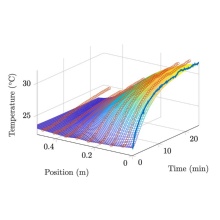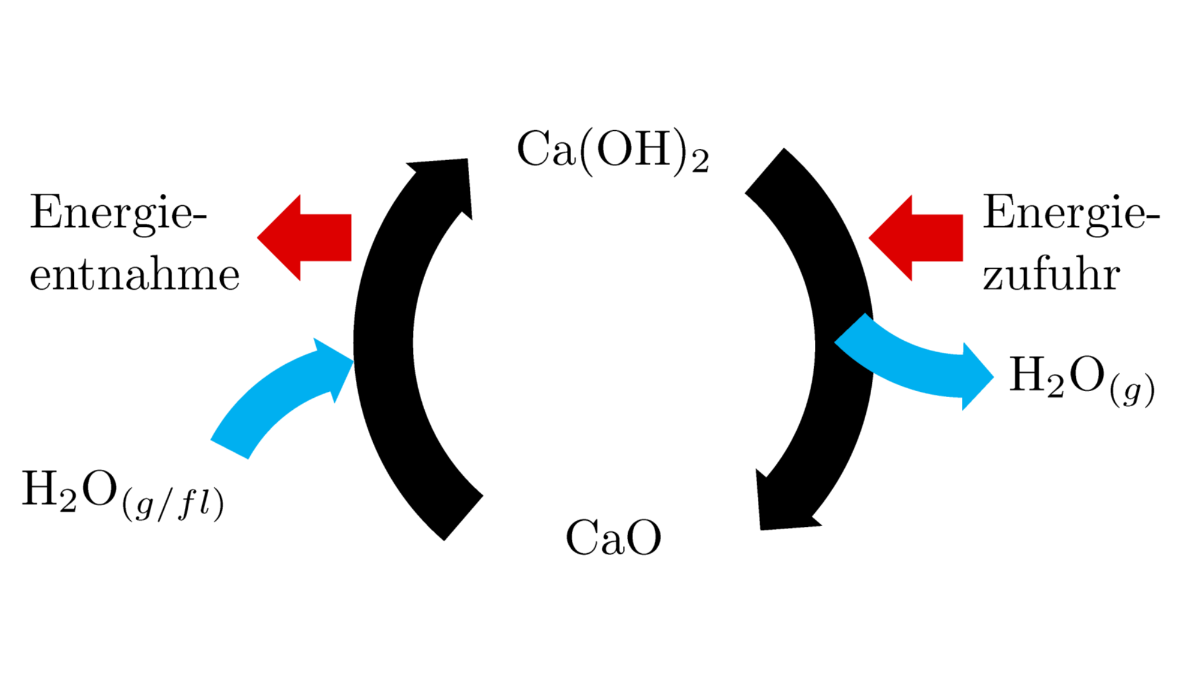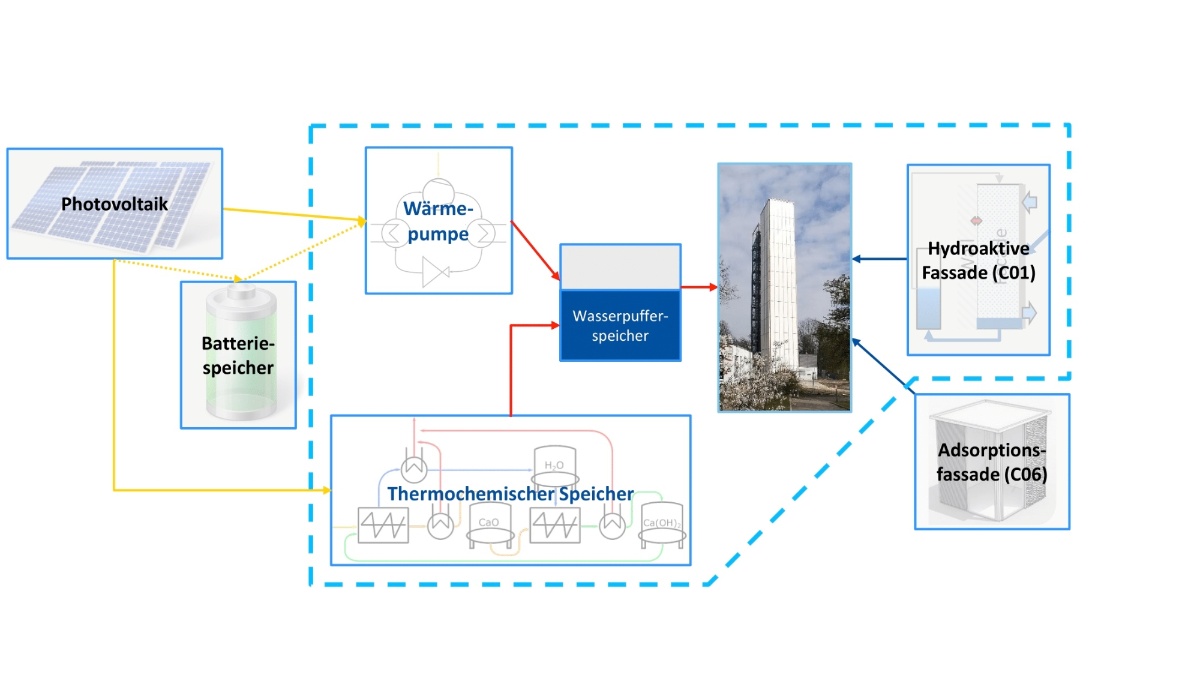Funding Phase II
A large portion of the total resources expended in the operational phase of a building is required for the thermal conditioning of the interior.
Two aspects characterize this energy demand:
- currently, the majority of the demand in Germany is covered by fossil sources, and
- the energy demand is subject to strong seasonal fluctuations.
Several projects within the CRC 1244 focus on the development of active facades with storage capabilities in order to achieve resource-efficient buildings in construction and operation.
In addition to this, subproject A05 is concerned with building integration of a thermochemical energy-storage system based on slaked lime. This innovative solution can be used for loss-free long-term storage of surplus electrical energy from renewable sources. The stored energy is released for heating when required. For this application, we direct our research towards finding suitable materials and developing a building integration concept for all necessary components. Additionally, the underlying control loop designed in A05 ensures a smooth and efficient operation.
The efficient operation of these storage-capable components is based on an operational strategy that plans the charge and discharge of storage units ahead. In addition to long-term planning, the system must also serve the short-term demand arising from thermal conditioning of the building. The underlying task is an optimization problem with the objective of minimizing environmental damage, which is solved repeatedly in the form of model predictive control. The results of these investigations are demonstrated using the prototypes that will be integrated into the demonstrator high-rise building.
Literatur:
Flemming, Daniela; Zhao, Mosha; Harder, Nadine; Park, Sumee; Leistner, Philip (2020): Parameterstudie zum energetischen Einsparpotenzial mit adaptiven Fassadenelementen zur lokalen Heizung. In Bauphysik 42 (2), pp. 63–72. DOI: 10.1002/bapi.202000001.
Oei, Marius; Guenther, Janine; Böhm, Michael; Park, Sumee; Sawodny, Oliver (2020): A Bilinear Approach to Model Predictive Control for Thermal Conditioning of Adaptive Buildings. In IFAC World Congress.
Oei, Marius; Klett, Yves; Harder, Nadine; Flemming, Daniela; Sawodny, Oliver (2019): Modelling the Flow and Heat Transfer Characteristics of Perforated Foldcore Sandwich Composites for Application in Room Air Conditioning. In : 2019 IEEE 15th International Conference on Automation Science and Engineering (CASE). August 22-26, 2019, Vancouver, Canada.
Guenther, Janine; Oei, Marius; Harder, Nadine; Sawodny, Oliver (2019): Simulative Study and Potential Analysis of Inflatable Facade Elements to Balance Environmental Disturbances. In SMART.
Flemming, Daniela; Eitle, Adrian; Park, Sumee (2019): Thermische Behaglichkeit bei Temperaturübergängen. In Bauphysik 41 (4), pp. 205–216. DOI: 10.1002/bapi.201900017.
Subproject Leader
- Prof. Dr.-Ing. Oliver Sawodny, Institute for System Dynamics
- Dr. rer. nat. André Thess, German Aerospace Center
- Dr. Marc Linder, German Aerospace Center
Funding Phase I
The aim of project A05 is to develop building physics system concepts for adaptive structures and planning methods for their design and operation.
IABP
The subproject investigates the following scientific questions::
- Can an equally comfortable environment be created at lower room air temperatures by heating close to the body (e.g. by adaptive façade elements) as under neutral conditions?
- Does the perception of local asymmetry differ from homogeneous conditions also for the same total thermal load?
- Does the type of heat transfer (radiation or convection) and the positioning of local heating elements influence the comfort rating?
Adaptive ultralight structures offer great energy-saving potential due to their ability to adapt to changing conditions. Due to adaptive façade elements and the lack of thermal mass, adaptive ultralight buildings can locally ensure an optimal quality of ambient and without time delay, especially when a workplace is used temporarily. So far, thermal conditioning has still been based on stationary temperature set points. Therefore, an appropriate set point temperature must be reached before the user arrives in the room and must be maintained for the entire time-of-use. Whether a user is actually present in the room is not taken into account. Adaptive structure elements with integrated heating or cooling elements ensure that a significantly lower temperature level is sufficient during the heating period. In order to guarantee thermal comfort under such conditions, a comfort model is developed by which the inhomogeneous boundary conditions can be evaluated regarding user comfort. For this purpose, different scenarios were tested in the HiPIE laboratory at the Fraunhofer IBP, based on which the model is developed.
ISYS
The project investigates the following scientific questions:
- How may adaptive components be integrated into existing control concepts?
- Which requirements on the actuators and sensors result from the interplay of adaptive components and a transient comfort model?
The goal is to create a modular and parametrizable simulation database for the analysis of various configurations. For this purpose, dynamic models for system components with building physical adaptivity will be developed.
An active control concept is necessary to utilize the interrelations between system components determined in the model and to meet user comfort requirements. It will be developed based on a new synthesis model and serve to ensure user comfort within the rooms.
Requirements for actuators and sensors for adaptive components are derived from the investigations in A05. The developed control and regulation concepts are tested and validated in simulations using exemplary room models. In the further course of the project, the control system will be implemented in a sample unit of the demonstrator and validated experimentally.
Subproject Leader
- Prof. Dr.-Ing. Philip Leistner, Institute for Acoustics and Building Physics
- Prof. Dr.-Ing. habil. Dr. h.c. Oliver Sawodny, Institute for System Dynamics
Contact

Anja Rentz
M.Sc.Doctoral Researcher

Viktor Kühl
Dipl.- Ing.Doctoral Researcher




